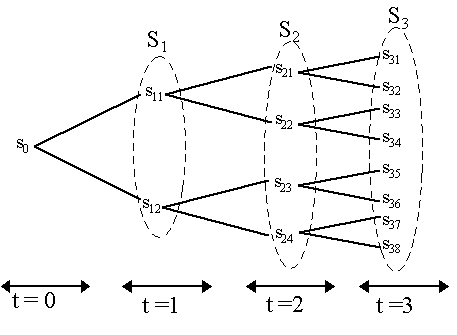|
Notation So far, we have restricted ourselves to two time periods. However, extending this to more time periods does not pose any great difficulties. Starting from an intial state in the initial time period t = 0, agents face a sequence of sets of states S1, S2, .., St, ..., ST where St represents the set of states at a particular time period t. As we know from our discussion of the gradual revelation of information, we can represent multiple time periods and successive sets of states as a tree from the initial state at t = 0 to a set of final states at t = T. This is shown in Figure 5 for four time periods, t = (0, 1, 2, 3) and three sets of states, S1, S2, S3. Any node on the tree represents a particular state at a particular time, i.e. st Î St. We also know that every node st can be represented by a time-event pair (t, Ai), where an event Ai is a set in the partition of the set of final states ST from the perspective of the node at t, i.e. Ai Î J t where J t is the information structure at time t.
"History" represents a particular path from the initial state to some final state, e.g. s0 ® s11 ® s22 ® s34 is one possible path of history chosen by "Nature". We wish to consume at every date and a particular endowment will be realized at any particular node. However, if we wish to consume more or less at any node, then we need to be able to transfer purchasing power across nodes. In Arrow-Debreu, we would just buy different state-contingent commodities in the initial time period for delivery at different nodes. In a Radner context we do not have this facility. There will be spot markets open at every node that permits us to buy commodities, but to transfer purchasing power across nodes requires, of course, the use of assets. There are effectively three types of ways by which we can envision doing so. The simplest would be to buy assets of different maturities at the initial time period. For instance, we could buy a short-term asset which has payoffs in different states at t = 1 and then a long-term asset which has payoffs at different states in t = 2 and even more long-term assets which only have payoffs in states further on. In this case, we need asset markets for all sorts of short-term and long-term assets open at t = 0. An alternative way we might envision this would be to merely have a succession of short-term asset markets which are nonetheless open every period. In this case, in the initial state we would only buy assets that have payoffs in period t = 1; but then, once we arrive at a particular state at t = 1, say s11, then asset markets would be open and we would be able to buy another set of short-term assets in the asset markets that are open at s11 to transfer purchasing power to the next period, t = 2. Then, letting time go on to t = 2, then another set of asset markets would be open in the particular state realized (e.g. s22) which would permit us to buy short-term assets with payoffs in period t = 3, etc. The difficulty with this last option, however, is that the Radner equilibrium requires that we plan all our future purchases ahead at the initial time period. Thus, we cannot wait for time to unroll itself in order to decide our asset purchases or else uncertainty will be "resolved" before all decisions are made - which goes against the purpose of the Radner equilibrium Consequently, we must have it that at time t = 0, agents make future asset purchasing plans contingent on the state of nature. To have this, we need to enrich our notation considerably and represent nodes by time-event pairs, (t, A), where A Î J t is an "event" in the information structure at time t. Let ptA be the spot prices at the node represented by time-event pair (t, A) and xtAh represent the bundle of physically-differentiated commodities demanded at that node. Asset prices at node (t, A) can be denoted qtA. We can let qtA(t+1, A¢ ) represent the price at node (t, A) of an asset which pays off in a successor node, (t+1, A¢ ). By "successor" we mean that (t, A) and (t+1, A¢ ) are connected in the tree, e.g. in Figure 5, node s22 is a "successor" node to s11, but s23 is not. To guarantee succession, then, we need it that the future event A¢ Î J t+1 be some subset of the current event, A Î J t, that is, A¢ Ì A. The reason for restricting asset prices in this manner ought to be obvious: in order to obtain a Radner equilibrium, we work with a series of budget constraints confined to each "node" (just like in the previous case, we had a budget constraint for each state). But an agent will not buy assets at a particular node which pay off in nodes that do not succeed it, e.g. at node s11 he will purchase assets which pay off in s21 or s22, but will not buy assets that pay off in s23 or s24. Let atAh denote the set of assets purchased at node (t, A). Let atAh(t+1, A¢ ) be the amount of an asset purchased at node (t, A) that pays off in successor node (t+1, A¢ ). Thus, qtAatAh represents the total value of asset purchases at node (t, A), which can be written more explicitly as:
where the summation is over the set of successor events, {A¢ Î J t+1 | A¢ Ì A}. We now want to construct the budget constraint at a particular node (t, A). Total expenditures would be purchases on spot markets for goods at that node, ptAxtAh, plus purchases of assets at that node, qtAatAh. To conduct these purchases, the agent obtains revenues from his endowment at that node, etAh and from the payoffs of assets previously purchased at the node to which (t, A) is a successor. Thus, letting (t-1, A-) be the predecessor node (thus A- Î J t-1 and A Ì A- ), then we can let VtAat-1A-h(t, A) be the returns at node (t, A) of assets purchased at the predecessor node (t-1, A-). Thus, the budget constraint at a particular node (t, A) can be written:
Thus, an agent at time t = 0 faces a series of such constraints for every node (t, A) in the tree. Again, like in the information case, we restrict sets so that the corresponding vectors are measurable with respect to the information structures (J 0, J 1, ..., J t, J t+1, ..., J T). Let xh be the agent's consumption vector where xh = [x0h, {x1Ah}AÎ J 1, {x2Ah}AÎ J 2, ..., {xTAh}AÎ J T] , is a vector which contains a list of commodity bundles purchased at each node. Thus, the individual optimization problem would look something like:
As we can "reindex" goods so that each "physical commodity" represents a physical good at a particular time and let the set of statee S be the list of end-states of the system, we could rewrite the entire system as a regular Radner sequence economy with S+1 states and solve as before. The multiperiod economy is isomorphic to the simple two-period economy, thus the results that obtain in the latter apply to the former. There is, however, still a third possibility by which we can incorporate assets in multi-period models. Instead of a sequence of short-term assets which pay off in every period in different nodes (as we had before), we could have instead a set of "long-term" assets which pay off only in the end-period, but can nonetheless be traded at every node along the way. In this case, agents at a particular node (t, A) who are worried about transferring purchasing power to a successor state (t+1, A¢ ) need not buy an asset that pays off in (t+1, A¢ ) but rather buy an asset that pays off in some endstate (T, s) where s is the final end-state of a path that passes through nodes (t, A) and (t+1, A¢ ), thus s Î A¢ Ì A. Consequently, if it happens that the next node is really (t+1, A¢ ), then the agent will merely sell the long-term asset at that state and increase his purchasing power at that node by qt+1A¢ aTs(t+1, A). Thus, his budget constraint will be transformed accordingly. What guarantees completeness of markets in this case? Let S(t, A) denote the number of successor states to node (t, A); if the number of assets available at node (t, A) is F(t, A), then the matrix of returns is a S(t, A) ´ F(t, A) matrix V(t, A). Thus, for completeness, we would need it that rank(V(t, A)) = S(t, A) for every node (t, A). However, as we shall see later, with long-term assets that are repeatedly tradeable, the necessary asset structure may be actually quite weak. This follows the insights of Kreps (1982) and Duffie and Huang (1985), as we shall discuss later.
|
All rights reserved, Gonçalo L. Fonseca


